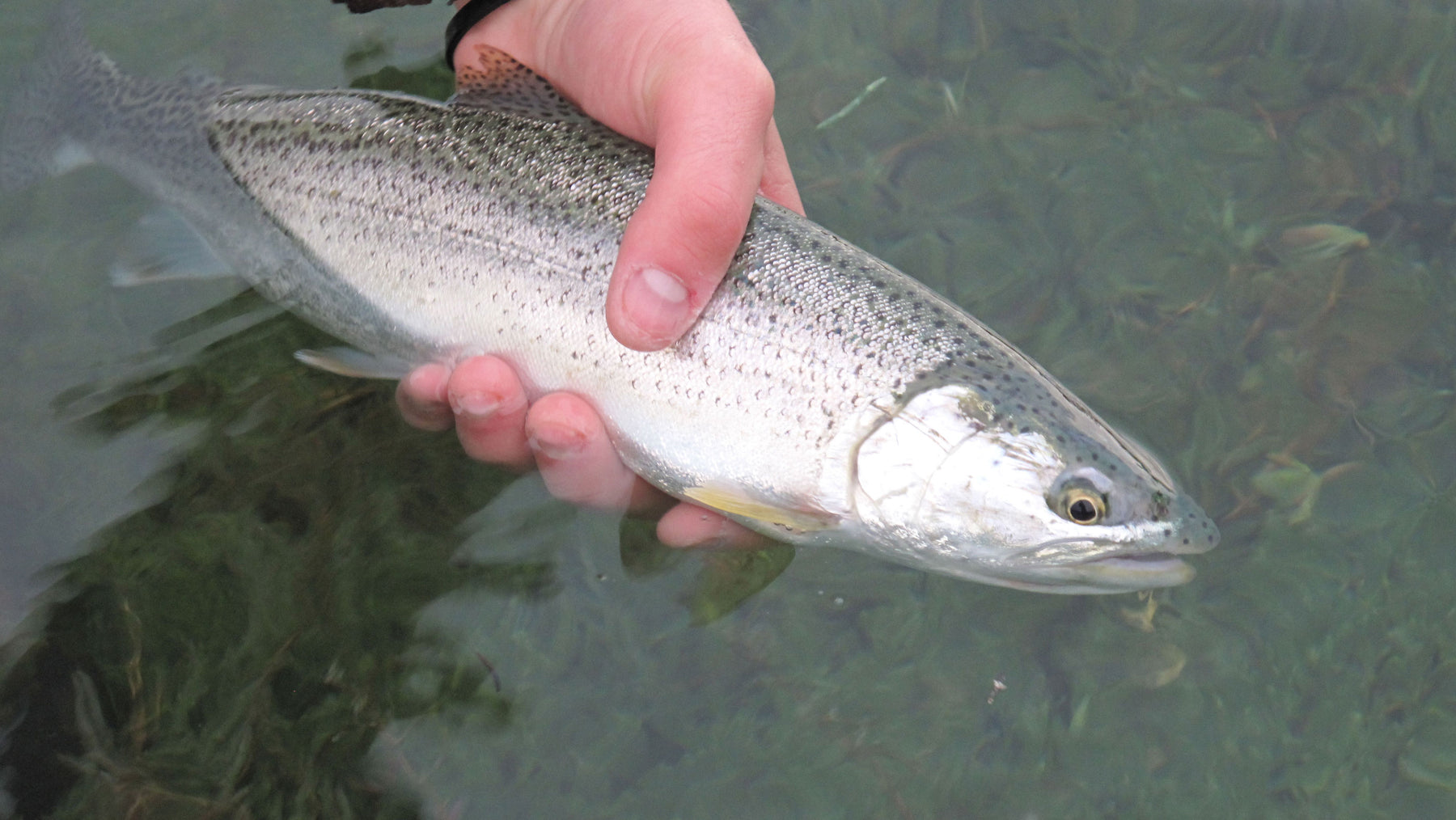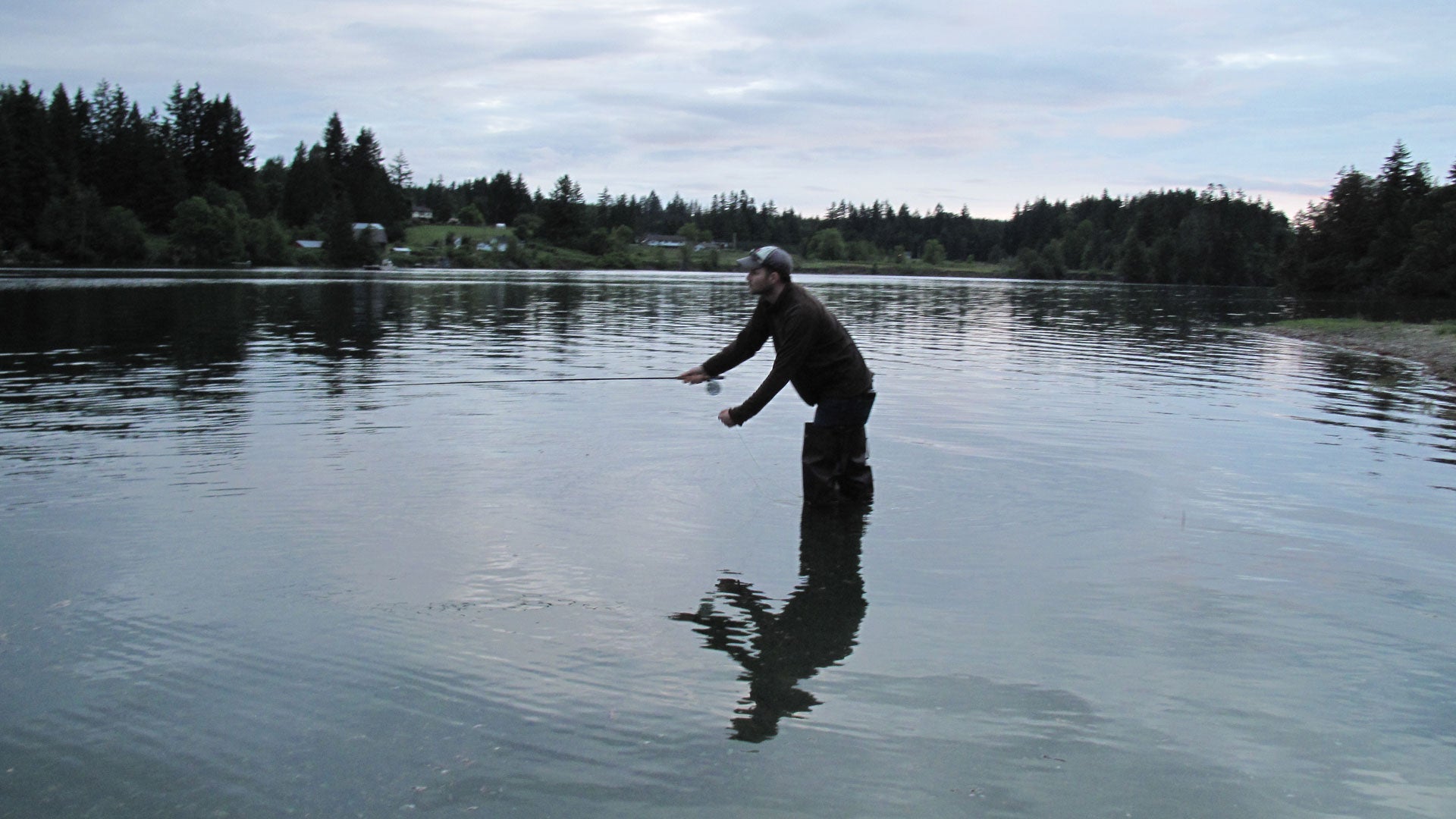8 AM - 4:30 PM (PST) Mon-Fri
8 AM - 3 PM (PST) Mon-Fri

By Jason Brooks
Standing at the water’s edge while peering into the clear water in the early morning light, I could make out fish shapes. Moving along the cobble of a rocky beach, we could see sea-run cutthroat trout feeding on small snails and aquatic insects while waiting for the tide to change.
Tidal changes flush food to the awaiting trout and the spring that results in salmon fry being flushed down from coastal rivers and streams. Being cautious as to not to get too close and scare the fish, I tried to figure out how to cast my fly out to the hungry trout.
I knew the grey morning would keep the fish biting longer than normal since the dark waters hid them from osprey and eagles. My fishing partner pointed his rod towards the water at a fish that was feeding on the bottom. With the tip of its tail barely visible above the water’s surface, the fish found snails and small bugs just mere feet from the shoreline. I guessed it was about a 12-inch cutthroat swimming in 6 inches of water.
Standing several feet from the shoreline, we began casting, landing the fly as gently as we could on the surface. At first, my buddy just let the fly sit there, watching as the ripples spread until the water was calm again. Then, he began stripping the fly at an even pace until I saw him quickly lift the rod with an arch. I heard him whisper “fish on." He played with the fish until it finally came to the beach. Picking it up gently, he showed me the bright silver fish with its dark freckles - the cut under its mouth was a dull orange. Removing the fly from its mouth, he slid the fish back into the water. Puget Sound’s sea-run cutthroat, also known as coastal cutthroat, is a catch-and-release fishery.
As the night’s shadows faded, we stepped further into the water. Fish were now surfacing about 20 feet out, and I realized the fish were moving to deeper water as the cover of darkness protecting them from overhead predators was gone. Their camouflaged backs helped the cutthroat in the early morning light and soon the surface was erupting in feeding fish. I tied on a Mack’s Lure Smile Blade Fly in Pink Sparkle hoping to mimic some sort of shrimp or other swimming food source.
Stepping out into the deeper water, we began to cast by reaching far back with a pause, allowing the line to catch up with itself, then thrusting it forward and laying the line gently onto the mirrored surface of the water. Each fly made a small circle as it landed. I would only make one or two casts between fish, with most coming in around 10- to 12-inches in size. Then my fishing partner set the hook on another fish. This time he didn’t whisper as he said, “Fish!” The "cutty" erupted out of the water and was all of 16 inches. He kept the pressure on the fish until he was able to slide it into his open palm. Once I had captured a photo of the moment, he eased the large trout back into the water.
I ended up landing two more trout before I felt the water rising and the tide incoming. Soon, seaweed and kelp began clogging our fishing grounds. The cutthroat were still rising, not as prevalent as before, but they were still feeding when we called it a morning. We had figured out why there was a short window for fishing - the same tides brought in the small schools of chum fry for the cutthroat to feed on, which also made it impossible to fish for them once the tides slowed and the water filled in with weeds.
As we walked back up the dirt road to our trucks, I said to my friend that this would be a fun fishery on my three-weight fly rod. He agreed but warned that resident Coho swim in these same waters and eat the same small fish and bugs. If I were to hook a Coho salmon, I would surely lose the fish and fly.

To fish for Puget Sound cutthroat all you have to do is look for beach access along any point, bay, or cove and you will find fish. Luckily there are plenty of state and county parks that offer just that. In the south sound look to Sunnyside Beach Park near Steilacoom or Penrose State Park on the Key Peninsula for access. Near Tacoma just south of the Narrows Bridge is Narrows Park which provides great beach access all along the west side where the fish feed during the slack and low tides. Walk north to Point Evans and fish the back eddy on the outgoing tide or right at the marker on the incoming tide. Dash Point State Park offers fishing along the banks near the fishing pier but there is no need to venture out onto the crowded pier as the fish cruise along the shoreline. The public beaches near Kingston and Point No Point Lighthouse can be productive for those on the Kitsap Peninsula. Across the sound from there the beaches along Whidbey Island are just as good, try Fort Ebey State Park or Fort Casey State Park which has over 10,000 feet of saltwater shoreline to fish. If you have a boat, then the entire Puget Sound that offers grassy coves or jutted points is at your mercy. Finding a place to fish and finding the fish themselves isn’t a problem, and this is one of the most underfished fisheries that I have discovered.
Clouser minnows are the most popular fly patterns, with olive green and white or bright green and white being very effective colors. Shrimp patterns and sculpins will catch fish, as well. Damselflies in summer will draw cutthroats to the surface, too, which is where an Smile Blade Fly in Olive Green will work best. Be sure to pinch the barb as, in any other saltwater fishery for anadromous fish, the hooks need to be barbless. For the gear-angler pitching small spoons, such as the Hum Dinger 1/2 oz. in Silver Sand/Nickel or Blue Glitter/Nickel. Trolling them along the shoreline in a small boat is another great way to find where fish are actively feeding.

My friend was right about keeping your gear fairly stout for these little trout. A six-weight fly rod is ideal as you still get to fight the fish but isn’t too overbearing. During the summer and fall, you might want to consider using an eight-weight rod as the resident Coho, as well as migratory Coho, are moving in and chasing the same baitfish as the sea-run cutthroat. We fished floating lines since this allowed us to pause before stripping in the flies as the cutthroat are pretty skittish to overhead dangers. Tippets were fairly long, again due to the jittery fish. I started my tippet with a 24" section of 15-pound clear monofilament and then stepped it down to a 24" section of 10-pound test to the last 36" section of 6-pound test. I favor Izorline’s XXX, which is strong yet limp, and I used a blood knot to connect the sections.
The best times to fish for sea-run cutthroat trout are early mornings and late evenings as the fish use the low light to come to the surface and feed. Tides are also a factor as they move the bait and weeds around. If you find a day where the tide is incoming with an hour or two of first light just before the high tide then it’s time to go fishing. I have found that even on weekends the beaches are almost completely void of people in the early hours of dawn. The evening time can be a bit harder as you have beachcombers, joggers, swimmers, and people throwing sticks for their dogs at the water’s edge, but if you have a beach of solitude then this can be another great time to fish. It’s hard to beat an evening swinging a fly into Puget Sound from the shore for sea-run cutthroat trout.
You don’t have to fish in the spring or summer as any time of year you will find the fish cruising the shoreline. Most marine areas are open year-round but all cutthroat fishing in Puget Sound is catch-and-release only. Make sure you check out the local regulations regarding park hours when fishing at public beaches, though most open before sunrise and close after sunset.